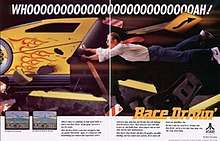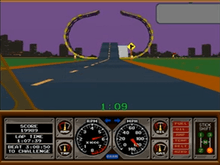Race Drivin'
Race Drivin' is a driving arcade game that invites players to test drive several high-powered sports cars on stunt and speed courses. The game is the sequel to 1989's Hard Drivin' and was part of a new generation of games that featured 3D polygon environments. Unlike most racing games of its time, it attempted to model real world car physics in the simulation of the movement of the player's car. Like Hard Drivin', the game is unique among video games in that it includes a true force feedback steering wheel, an ignition key, a four-speed shifter, and three foot pedals: an accelerator, a brake, and a clutch (the clutch being a control seldom seen in any video game, then or now). Released in August 1990, approximately 1200 units were produced at the time of its release for roughly $9000 each.[1]
| Race Drivin' | |
|---|---|
 | |
| Developer(s) | Atari Games (arcade) Argonaut Software (GB) |
| Publisher(s) | Atari Games (arcade) Domark THQ (SNES/GB) Tengen (Genesis) |
| Composer(s) | Don Diekneite (arcade) David Whittaker (GB) Mark Van Hecke (SNES) |
| Platform(s) | Arcade, SNES, Amiga, Game Boy, Genesis, Saturn |
| Release | Arcade
July 26, 1991 SNES, Amiga
|
| Genre(s) | Driving simulation |
| Mode(s) | 1-2 players alternating |
| Cabinet | Upright, cockpit |
| CPU | 68010 TMS34010 DSP32C |
| Sound | Unamplified stereo |
| Display | Horizontal Raster 512 x 384 (cockpit) 336 x 240 (upright) |
Race Drivin' was ported to a number of home systems in the mid-1990s, including the SNES, Amiga, Game Boy, Genesis and Saturn. In 2005 it was included in the Midway Arcade Treasures 3 collection for the PlayStation 2, GameCube, and Xbox. A 32X version of the game was planned, but was moved to the Saturn.
Gameplay

The gameplay resembles a driving game, featuring 4 different cars (3 with manual transmissions (speedster, roadster, and original), and 1 automatic (original)) and 3 different tracks to choose from (the regular stunt track which is very similar to the one in Hard Drivin', the Autocross track, and the Super Stunt track). The screen shows a first person perspective from inside the car, through the windshield. The cars dashboard is visible and displays the cars instruments, like the speedometer, tachometer and fuel level, as well as a few other non-gameplay important ones, such as the oil, temp, and amp dummy lights. Each car has its own unique dashboard.
The game generally consists of racing 1 or 2 laps around the player's chosen track within the allotted time. The gameplay and vehicle operation in Race Drivin' are very similar to Hard Drivin' and gameplay elements such as the Instant Replay and the off-road timer are still there. A noticeable difference between the two games though is that although the car traffic in Race Drivin's stunt track is still there like in the original Hard Drivin' track, the two new tracks included in Race Drivin' (Autocross and Super Stunt track) are absent of any additional car traffic. Also, unlike Hard Drivin's original track that offers the driver two different driving paths, the two new tracks in Race Drivin' only offer one driving path per track. The finish times of the new tracks are very different as well. The original track shared by Race Drivin' and Hard Drivin' takes roughly 1:30 to complete. By comparison, the Autocross track is very short requiring roughly only 30 seconds to complete and the Super Stunt track is considerably longer (taking roughly 3 minutes to complete).
Like its predecessor Hard Drivin', the game features an ignition key, a realistic manual transmission mode (which includes a 4-speed shifter (with neutral), a clutch pedal, and the possibility of stalling the car should one mis-shift) and a force feedback steering wheel, in which the driver has to all properly operate as they would in a car in real life. The cockpit version of the game also includes an adjustable bucket seat and, if it is a 'Panorama' version (of which only 100 were made), it sports 3 to 5 monitors for a full 180° peripheral view.[2]
Enhancements
Race Drivin' improved upon its predecessor in several ways.
- It had improved handling courtesy of a faster microprocessor and more efficient software. The TMS34010 used for car modeling was replaced with an AT&T DSP32C which is faster and has floating point. Now, instead of modeling a car with only two wheels as Hard Drivin' did, Race Drivin' could model a car with all 4 wheels.
- 2 more tracks and 3 more cars were added. The stunts in the new Super Stunt track were either enhanced versions of the original ones (for example, Hard Drivin's 'loop' became taller, requiring more speed, and was now called a 'jump loop' because it had an open gap at its peak, and the ramp jump now had two separate landing ramps, each requiring a different speed) or new stunts entirely, like the corkscrew loop, the mountain road, and the 45° vertical hill.
- Race Drivin' also introduced 'Buddy Race', where a second player could race against a previous player's recorded performance, and 'Linked Race', where by connecting a cable between two Race Drivin' cabinets, players could race each other simultaneously.[1]
Development
Doug Milliken, who also worked on Hard Drivin', is credited as a "test driver", but actually worked as a consultant for developing the car model. This model was used to lay out the physics of the game's car.[3][4] The arcade version of Race Drivin' was exhibited at the UK Amusement Trades Exhibition International in 1991.[5]
Reception
| Reception | ||||||||||||||
|---|---|---|---|---|---|---|---|---|---|---|---|---|---|---|
| ||||||||||||||
Electronic Gaming Monthly gave the Genesis version a 4.6 out of 10, calling it "another so-so entry in the driving scene" due to its "very choppy" scrolling.[6]
References
- "Race Drivin' arcade video game by Atari Games (1990)". Arcade-history.com. Retrieved 26 October 2018.
- "Race Drivin' Panorama arcade video game by Atari Games (1990)". Arcade-history.com. Retrieved 26 October 2018.
- Margolin, Jed (March 9, 2002). "Schematics for Hard Drivin'/Race Drivin' ADSP, Motor Amplifier, and DSK Boards". Retrieved 10 October 2014.
- "Karl Ludvigsen - Mister Supernatural - Bill Milliken". Bentleypublishers.com. Retrieved 26 October 2018.
- Nesbitt, Brian (February 1991). "Coin-Operated Corkers!". The One. No. 29. emap Images. p. 20.
- "Review Crew: Race Drivin'". Electronic Gaming Monthly. No. 54. Sendai Publishing. January 1994. p. 46.
- "Midway Arcade Treasures 3". GameSpot.com. Retrieved 26 October 2018.
- Nintendo Power rating, issue 43, page 109, Dec 1992
- Nintendo Power rating, issue 45, Feb 1993
- Super Play rating, Jan 9, 1993
- SEGA Pro rating, issue 25, page 54-55, Nov 1993
External links
- Race Drivin at Arcade History
- Race Drivin' at the Killer List of Videogames
- Race Drivin' Resource